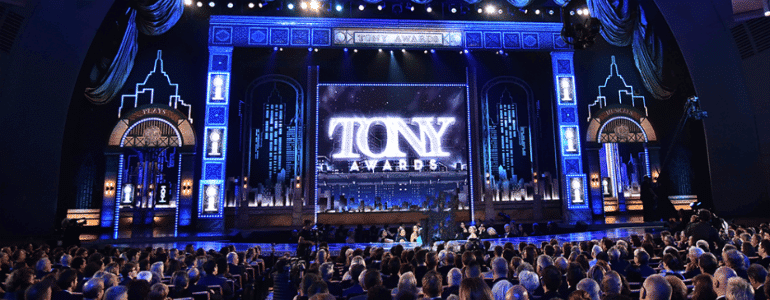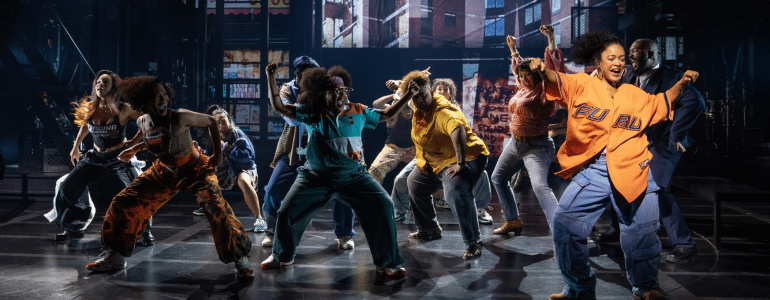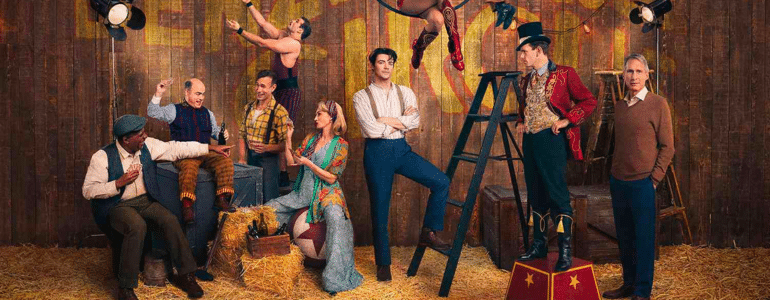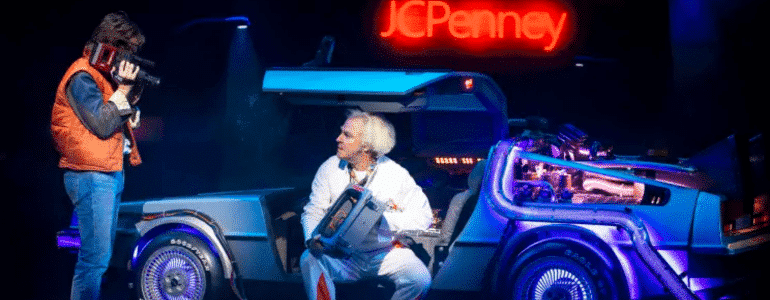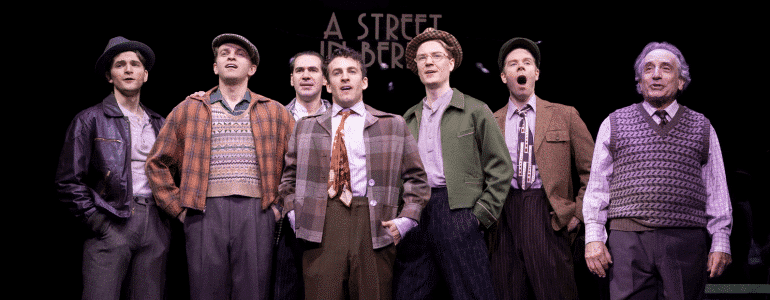Podcast Episode 14 Transcript – David Rockwell
Ken: Hello, everybody and welcome back. I am Ken Davenport and this is the Producer’s Perspective Podcast. As you all know, the theater industry is very niche business. Usually the people who work here work only here because their knowledge is so very specialized. It’s a very small group of super talented people that can work both inside and outside our industry in their discipline and today I’m sitting with one of those people, if not the best example of them. I’m here on the main stage of my theater with three-time Tony nominated Broadway set designer David Rockwell. Welcome, David.
David: Nice to be here.
Ken: Now you all know David’s sets, from Kinky Boots, Lucky Guy, Side Show, Hairspray, etc., etc., etc. But do you know about his other work? Well, I’m sure you do. How about the restaurant Nobu? I can’t get in there myself but I’ve seen pictures, it’s stunning. Or how about this one, the Cosmopolitan Hotel in Las Vegas? I have lost many, many a dollar on the floor of that casino. Or how about the JetBlue Terminal Five at JFK? So, as you can see, David and his 250 person firm works in a variety of disciplines so, first of all, let me say, David, thank you for sharing your immense talents with the Broadway industry. But I have to ask, compared to so many of your projects, like Grand Central, for goodness sake, the theater seems like such a small industry for you to focus so much of your time on. So why? Why do you do it? What brought you here?
David: It’s a great question and I think the answer, which I’m not going to be particularly fluent about, is because, as a creative individual, I’ve really come to the conclusion that most architects and designers and set designers pursue what they’re interested in, pursue what they’re passionate in and then later on you can look in the rearview mirror and figure out what motivated you. But I will tell you that, from the moment I can remember, I was intrigued by the notion of the theatrical space, probably due to my mom, who was a dancer. I’m the youngest of five boys so by the time I came around she was not actively dancing, but we were living in a very private suburb of the Jersey shore and she started a community theater and I think the way I learned to engage in the world, the way I learned to communicate, was by making things. Rube Goldberg contraptions . . . I was always in the process of building. And so when this community theater started to happen a light went off in my head that the most exciting place in this community was the three months that multiple groups were being brought together. So I think my key into design originally had more to do with how design connects people, and as the journey went I moved much more into architecture and my interest in theater became the stuff I referred to, to make the architecture more exciting. So you can imagine 20 years ago, when we were doing the first Nobu, for instance, and I said to Drew Nieporent and Robert De Niro and Nobu Matsuhisa that one of my ideas was to stencil cherry blossoms on the ash floor as a reference to Madame Butterfly, they looked at me like I had lost my mind. But they indulged that, that instinct believing that it somehow could lead somewhere. So it’s been an incredible gift in my life and really unexpected that I would dive into theater and be welcomed by the community you described in such a complete way.
Ken: Did you design for your mom’s community theater back then?
David: It’s funny you should ask me that. I was 12 so I wouldn’t say I was designing but I did paint and one of the things I worked on was the set for The King and I for the Deal Community Players and I recently collaborated with Don Holder, the incredible lighting designer, and he lit On the Twentieth Century and The King and I and I said, “You know, Don, I had this thought that I created this great version of The King and I when I was 12,” and I went back and l looked at the photographs and it was more lower tech than Waiting for Guffman. So I was really more of a kid actor in the productions that we did and I had opinions on design, I think.
Ken: I had a lot of opinions on the producers of our little community theater as well, which my parents got me involved in, the same story.
David: Where was that?
Ken: In Sturbridge, Massachusetts. I got dragged to an audition when I was five years old and it stuck. Community theater, the entry point for a lot of professionals these days. So you didn’t go the Broadway theater route right away, right?
David: Not at all. We moved to Guadalajara, Mexico when I was 12, unexpectedly. As a 12 year old you don’t get the sense, “we’re moving in six months,” and then you end up in a place that could not be more different, starting with the fact that no one spoke English. We were 8,000 feet above sea level. It was really like being a stranger in a different land and my interest in theater really morphed into an interested in public spaces and public theater. Mexico, and Guadalajara in particular, was all about festivals and mariachis and marketplaces and as I started to get fascinated with how physical places were formed, my interest in architecture started to take shape. What I found most intriguing, and it’s what I still find most intriguing about public spaces, is not any one building but the choreography that moves you from place to place, kind of the connective tissue between buildings. And that led to studying architecture at Syracuse University, a great education but very much a kind of modernist “Architecture-with-a-capital-A” point of view, but I did find a way to keep alive my interest in theater. I came to New York every summer and worked. If I saw a show that I liked I would go and see it literally the next day (at that point TKTS allowed that) so it was a hobby and a vocation and an obsession, but I found ways to work in architecture. And what I started to discover was that taking notions of theater and embedding those into physical places makes them more engaging. So that continued, I then took a year off of school from Syracuse and studied in London at a place called the Architectural Association and was kind of reintroduced to the world of theater in a big way there, came back to New York and got a job for the summer working for a Broadway lighting designer named Roger Morgan, who had just done Dracula . . . which was unbelievable, with these Edward Gorey sets. I was a glorified assistant, but I drafted and was helpful. I got that out of my system and then went back to architecture school, finished and then came to New York. I really didn’t think seriously about trying to engage and actually design in the theater until about 20 years ago, so the architecture firm was already on its way.
Ken: One of things that I’m fascinated about most about people like yourself, designers and architects, is that obviously you’re an incredible artist and have to envision these beautiful, intricate, flowing designs, but at the same time you sit down, you draft it, you have to understand the science behind it all as well. What percentage is artist versus scientist? What do you think is more important to have, or which skills?
David: I don’t know how to answer that directly, but I’ve been thinking about the process because it’s our 30th anniversary as a studio and we had a book that came out so, for the first time, I had to acknowledge that it was a good idea to look back and see what our process was and track the connective tissue between the different projects that we were doing. And here’s what I discovered . . . and it’s something I talk about to students whenever I’m involved with a school . . . and that is that you have to start with research. You have to start by understanding the project, understanding, in the case of theater, On the Twentieth Century, for instance . . . I researched not only the history of the twentieth century itself but deco, the use of metal, posters from the period were really insightful because they got into the psychology of what made that so special, what made that combination of speed and optimism and luxury so unusual. You have to research the story, you have to meet with the director, you have to find the spatial problems, you have to have the toolkit to deal with those problems, the understanding of mechanics, how things move. You have to deeply engage with your collaborators, your lighting designer, backlit, front lit, thank about material palette. Then you have to take all of that and you have to conjure something that is an amalgam of all of those ideas that has a certain level of magic and an unexpected approach. And in each case there is that period where you feel like you’re not going to figure it out, because I think for a creative individual the worst possibility is knowing the answer before you begin, because then you short circuit that process. So it’s a combination of having the tools, delving into as much of the history as you can, and then finding all of the tangents. For instance, with On the Twentieth Century, I started to realize that our memory of that deco period is of a single mental, chrome, when in fact there was a rich palette of bronzes and golds and coppers and that freed up a certain kind of thinking about craftsmanship and then you need to think about, “How am I going to take all of this and create a sense of magic that invites the audience into the show, tells the same story the director wants to tell and provides the kind of world to tell that story?” Does that answer the question?
Ken: Yes, yes it did. When you were that kid coming into town and spending his summer here, what were some of the sets or some of the designs that blew you away back then?
David: I just recently read that they’re doing a TV version of The Wiz. I was blown away by the physical production of The Wiz at that time. Hal Prince’s Candide at the Broadway Theatre was an extraordinary experience. Tony Walton’s design of Pippin was, and is, and remains an unbelievable piece of magic, particularly that rope coming out of the floor, that rope castle. Peter Larkin’s design for The Rink was a seminal thing for me in terms of understanding transitions. The first Broadway show I saw when I was 12. My dad took us into the city right before we moved to Mexico, I went to Schrafft’s restaurant for lunch, which was my first New York restaurant. I was mesmerized by walking around the city, and then we went to the Imperial Theatre to see Fiddler on the Roof and Boris Aronson’s design, which is so linked to movement . . . and I recently had a conversation with Hal Prince, talking about that, just how kinetic that solution was. That was a powerful thing for me.
Ken: You mentioned the key word there, which I was taught a long time ago, about what makes a set, especially a musical set, work, which is transitions. A general manager said to me, “Yeah, this looks like an okay set but I don’t understand how this musical is going to move,” and that seems to be one of the key ingredients for a designer. Can you talk to me about that process? You have to get how many locations in one set? Whereas when you designed Grand Central, Grand Central pretty much stays where it is. What’s the process for determining that movement?
David: I felt like movement in architecture is something worth noting. For instance, the Paris Opera House. When you think about being in that Paris Opera House, at least half of the show is the movement in through the lobby, up the stairs, around the balcony and then peeking into this room that explodes into view. There, the transition is driven by the viewer. Theater, as far as I know, is the only art form where the transformation happens live in front of you. In fact, I’ll give enormous credit to Jules Fisher for encouraging me to take a leap into theater . . . and this was maybe 20 years ago. I was sketching at a show and he was a friend of mine and we were talking about it and he said, “Why don’t you just begin to speak to directors to understand what their needs are around storytelling?” And really it was and is transitions that are the single most important element because it’s what takes you from place to place. It’s what can build emotional movement. And in pretty much every show I mentioned that I was blown away by as a kid what you remember is pictures where the actors’ movement, the music, the physical set are all in some kind of dance together. Sometimes you’re creating the engine that’s going to drive the show. With Scott Ellis recently on You Can’t Take It With You, as I read the play I kept thinking there was something about the Sycamores . . . even though it was the 1930s, it was a very urban play. They’re in Columbia and I thought the non-conformity would be more tangible if the audience got a sense of what the rest of New York looked like. And that led us to a set that had two sliders that were much sketchier than the facade of the Sycamores’ home, and those represented the conformity of the rest of New York and when the show began, during each transition, those would slide off, and the set revolves 140 degrees and so you’re brought into the world of the Sycamores in a way that I felt would give the audience an interesting perspective and reinforce the power of the play.
Ken: Speaking of plays versus musicals, do you approach one differently to the other? Are they just all pieces of theater or does one require a different muscle when designing?
David: I think each project has to be taken as its own adventure. I think it’s a privilege to have each adventure and whether it’s a musical, a big musical, small musical, Off-Broadway, I think each project has its unique challenges. I’m a little bit like the person who’s sort of in love with the last project they’ve done. It’s just an indescribable thrill and, I will tell you, being able to work with the artists and craftsmen and people in the theater gives me insight into architecture that is creating opportunities I never expected would exist.
Ken: What was that first project that you dipped your toes into in the theater again, when Jules recommended you talk to directors?
David: Well it was three or four years of meeting with directors and designing things that didn’t happen, so there were several false starts. I started work on many musicals that didn’t happen. I won’t go into great detail of what they were but I fell in love with the projects, developed models, met with directors. And Jordan Roth and Chris Ashley called me and said, “We’re doing a revival of The Rocky Horror Picture Show and we’d love to talk to you about it,” and having spent all of those pop culture years in Guadalajara, Mexico, somehow I had never seen The Rocky Horror Picture Show. So I rented the DVD and I came in and I said to them, “I’m a little baffled, having never seen this in front of audience, what makes this a compelling piece,” because my thought was that theater might be the more academic partner than my populous day job, so I was thinking The Cherry Orchard, at BAM, not necessarily The Rocky Horror Picture Show, and Chris Ashley, who’s a brilliant director, said to me, “You know, David, in some ways this is an opportunity for you because it’s about self-creation. It’s about the moment where they’re stepping into the world of movies.” So I jumped in and we designed it two or three times, because it was going to be at different theaters. I went to the Circle in the Square Theatre, where I met Jerry Mitchell for the first time, who had bruises on his hips from teaching people to do the Time Warp, and let me tell you, that never occurs in architecture. I’ve never had a client show me bruises on their hips before, so I was sort of taken with that, and we got to the Circle in the Square Theatre and it was really a magical experience. Jordan was great. I think it was Jordan’s first Broadway show. And then Jerry, after that, introduced me to Jack O’Brien and suggested that I do Hairspray and that was indescribable.
Ken: Jordan did one of these podcasts and we talked about The Rocky Horror Picture Show a lot and I remember that and listeners out there, go and Google images of this, because if you’ve been in Circle in the Square, you have never seen Circle in the Square like this before. I was steps away from Dick Cavett, perched out over the group, it was fantastic, fantastic design.
David: One of the things we did, because we didn’t know you weren’t supposed to, is the entire set rotated and flipped into the floor, so the opening transition was thrilling.
Ken: A lot of people say Broadway requires a spectacle, especially scenically. You need, in The Phantom of the Opera, the chandelier. When you’re sitting down to design a new project, does that ever enter your mind? That the Broadway consumer, who’s spending $150-500 now, demands a certain level of razzle dazzle, if you will?
David: It really doesn’t because I think you can’t outguess what people are going to like. When I’m thinking about what projects to work on and where to put our time, I think trying to figure out what’s going to be successful is a no-win situation and the same is true about thinking about what an audience wants. You can think about what the best way is to present this material, you can think about how you break past the proscenium and get contact. What’s so incredible to me about theater, and what I think is so extraordinary about the people who work in the theater, is that it’s a temporal art form. So you can document it, but if you’re not there, you didn’t get it. It’s an hour and a half, two hour, two hour and a half experience that becomes an important part of our collective experience, our memory, based on having shared that, being there live. So as a designer I do think about how to make that extraordinary, but I don’t think it’s about big or small, I think it’s about how to have it feel connected and have the audience have a kind of visceral experience. You get to play with many elements, familiarity and surprise. You Can’t Take it With You, it’s a familiar, kind of Victorian world, but the surprise is that each element of the 250 things on the wall relate to some backstory in the play. So when you’re spending two hours with the Sycamore family you start to look at that. It’s not about spectacle but it’s about backstory.
Ken: Where do you think design is going over the next 10-20 years in the theater?
David: I really do believe any time you talk about a trend it’s already morphed and moved on. Having said that, I think audiences, maybe because we’re so connected in terms of technology, are creating more and more live experiences and I think how the theater responds to that is interesting. There are more and more artists pushing the boundaries of what theater can do, that’s always been the case. The history of theater is the history of constantly pushing various relationships between the audience and the performer, modifying that, finding ways that that story can connect. And technology has been a part of that as an ongoing story. But at the same time I think that there’s no one solution. So you say what direction theater is going in . . . I think the theater is very much alive, I think it’s unpredictable, I don’t think it’s about the latest whizz-bang technology, necessarily, because in many cases the oldest handcrafted piece is the thing that makes the most impact. I think, as it becomes expensive to load in shows and load shows out, there’s pressure to address that as a designer and think about the reality of giving the show a chance to run. So there’s, fortunately, no pat answer that I’ve discovered. It may exist but I don’t know it yet.
Ken: Are you a fan of projections and their use in the theater?
David: I think projections are essentially another way of doing a painted drop, so I think thinking of them as something that’s sort of bringing cinema into the theater is not the most useful thing for me. I think thinking of them as another tool, thinking of them as imagery, is interesting and it’s something we’re exploring right now with a project with Jerry Mitchell in a way that we haven’t explored before. It’s an interesting process because you’re creating a very textured world that will move and shift along with images, some of which will be light and some of which will be projection, but I’m certainly not a fan of the notion that the world is projected versus real, but I think there’s all kinds of amazing possibilities yet to be explored that we haven’t gotten a chance to use yet.
Ken: You’ve obviously worked with a lot of producers over the last couple of decades of your work here in the theater. I’d love to ask you for the names of your favorites and least favorites but I won’t put you on the spot. But tell me some of the characteristics of your favorite producers. What do you think the skills are that are required today to be a successful producer?
David: Enormous persistence, passion, thick skin, ability to seduce multiple groups to participate, trust in the artist and be able to step out of the way when it’s time to give some creative room to the team. Luck, I think luck is very important. The ability to really back something. I do have a newfound respect for producers and I’ve been thinking about it quite a bit and I think it has to do with just looking back and thinking about how much work it takes to rally all the forces to give the creative space for the team to do its work and then support that work, not knowing what the outcome is going to be. I think it takes a great deal of skill and energy and commitment and patience and luck.
Ken: Do you find similarities between producers on Broadway and restaurant owners or hotel owners? Is it the same kind of philosophy no matter what the company is that these people are leading?
David: That’s a great question. It’s one I haven’t thought much about. There’s no set type of restauranteur. There are restaurants we work on that are chef-driven, some are operator-driven, and I think that’s true about producers. I think there are some producers who are more focused on the creative piece and some are more focused on the business end. In the restaurant world, if you’re being led by a chef then there needs to be a business intelligence in the background backing that up and I think the same is true in producing. It requires a very well-rounded group, whether it’s one person or a group. I think there’s a similarity in the element of risk. The amount of money it takes to create a hotel . . . we’re doing a new hotel right now on Madison Square. It’s been going on for a long time . . . an enormously talented owner, Ian Schrager, partnered with Marriott . . . incredible taste, incredible persistence and really great leadership, as you might expect a director would have. So I think in some cases there are director-led productions, there are producer led productions . . . the same is true in hospitality.
Ken: A little birdie told me you might have some producing interest as well. Is that true?
David: Well, I don’t know about that. We worked for quite a while with Scott Sanders on Houdini and that continues to be something I’m interested in. It is so difficult, when you think about creating something from scratch that’s going to hit the mark, but I’m interested in all parts of it. It certainly is a great learning experience and I think learning every part of the job is a little bit like when I started doing restaurants. A chef I was working with said, “I’d like you to come and work in the kitchen. I’d like you to work front of house.” I think having a better understanding of the economics makes you a stronger designer and if it turns out that there’s a possibility for me to help create stuff, I’ll evaluate that as it comes along. The thing for me that is so special about the theater work is that it’s real time collaboration. You’re in one space with the director, the lightning designer, costume designer, and you’re creating stuff right then, together, and that is very unique. That’s not something that exists in any other world I’ve discovered.
Ken: I understand it may be challenging at times because your work is artistic and yet so scientific as well, to get notes from a restauranteur or a producer who doesn’t understand that work I’m sure can be challenging at times. So what advice would you give to someone like me . . . I’m not the most aesthetic guy, I don’t have anything on my walls at home, I couldn’t design anything . . . to understand your world a bit more? Like you said, you worked in the kitchen. What can a producer like me or someone do to understand a little bit about where you’re coming from?
David: I think trying not to be prescriptive. Notes are most useful when they’re describing what you’d like to see happen that’s not happening, what part of the story is not connecting, what part of the story is connecting. So I think one thing is not being prescriptive but at the same time being very direct about the parts of the story that aren’t working, not physically how to solve it because that stops the creative process as opposed to engaging it. I think clarity about budgets is very helpful because in many cases there’s a fuzziness. We did a restaurant for Danny Meyer at the Gramercy Park Hotel called Maialino. We talked about the exact budget, but every piece within that budget we could help mold . . . back of house, kitchen, front of house, chairs. So I think by bringing the designer really under the hood on what the overall plan is, because the weekly is, in many cases, a bigger killer than the cost of building the set. So understanding that and getting everyone on the creative team engaged I think gives you a better chance to succeed. Be empathetic, designers are sensitive and they want to get it all perfect and it’s never perfect, that’s one of the greatest truisms . . . you stop working on a show because it’s time to open, not because you’ve finished all the work, so I think empathy is good. Is any of that helpful?
Ken: Yeah, in fact I’m just going to clarify a bit, there tends to be this lack of transparency even between members of our own team at times. When my general manager is like, “Oh, Ken, we’re hiring this designer. We’re going to tell him the budget is X.”
David: It’s crazy, it happens all the time and it happens in architecture too. I’m a parent of two kids . . . it happens in parenting too, it’s called negotiating. If you say you’re going to bed at 10 but you really mean midnight it creates that fuzzy thing, so I think transparency is a good thing.
Ken: So you’re rather a producer or general manager come to you and say, “David, you’ve got $1 million . . .”
David: No, I’d rather they say $2 million.
Ken: I should have known! But you’d rather they give you that number, and you play with it however you want.
David: It’s also a good idea to set the budget after really knowing what the play demands. That is a pet peeve that you hear a lot in the theater. If the budget is set and fixed but it doesn’t match the ambition of the project, somewhere that’s going to have to be negotiated and figured out and it’s good to do that upfront.
Ken: So then the takeaway from that is that as soon as that director gets on board . . . because often we hire a director and we think we’re done for a while . . . the designer has to come on board right after the director and before you print your budgets and investment papers and all that, so that we go out with the proper raise.
David: Absolutely.
Ken: That’s a great, great takeaway for myself. Okay, last question. This is now becoming the famous genie question. I want you to imagine the genie from Aladdin appears and says, “David, I’m going to give you one wish. You can change anything you want about the theater industry with the snap of a finger. What’s been keeping you up at night? What’s been getting you the most frustrated? What drives you crazy? I’m going to change it however you’d like, but you only get one.” What would you wish?
David: I would never be good at the genie game because I’m not a linear thinker that way, so I’d probably ask the genie if I could trade the big wish in for three smaller wishes, but I’ll just make one up. I think the time pressure is really a killer in theater. And I know it’s an economic driver and I know it has to do with the cost of the real estate and the cost of the labor, but if I could make one wish it would be to have more time. You look at some of the stuff coming over from the National Theatre where they’ve had a huge amount of time and I think the gift of time for the creative team would be the best gift.
Ken: That’s a great answer and one we haven’t heard yet and I too would like some more time. David, thank you so much for your contributions to Broadway, to the city as a whole, to the world, everywhere I’ve been where I can always tell it’s stamped with the David Rockwell design, and it’s stunning wherever it goes. Thank you so much for being here, and for all of you, we will see you next time. Thanks so much for tuning in and don’t forget to subscribe!
Podcasting
Ken created one of the first Broadway podcasts, recording over 250 episodes over 7 years. It features interviews with A-listers in the theater about how they “made it”, including 2 Pulitzer Prize Winners, 7 Academy Award Winners and 76 Tony Award winners. Notable guests include Pasek & Paul, Kenny Leon, Lynn Ahrens and more.







